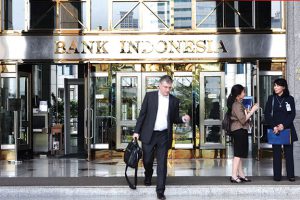Bloomberg
Indonesia’s central bank gave the first signs Thursday that it will begin normalising policy, even as it left its benchmark interest rate unchanged.
Bank Indonesia kept the seven-day reverse repurchase rate at a record-low 3.5% at its first monetary policy meeting of 2022, as predicted by all 29 analysts in a Bloomberg survey. In a briefing in Jakarta, Governor Perry Warjiyo said BI will start raising banks’ reserve
requirement ratio, hiking it to
5% in March with additional increases to come.
Indonesia’s tentative steps towards policy normalisation are among the first in Southeast Asia, putting it on track to keep pace with the Federal Reserve’s policy tightening. The decision came shortly after Malaysia’s central bank kept its benchmark rate at 1.75%, as expected by all 25 economists surveyed by Bloomberg.
“Putting the two central banks side by side, it is clear that Bank Indonesia has taken more concrete steps toward preparing for the eventuality of the new tighter Fed monetary policy stance,†with its RRR announcement and a more “pro-stability†versus “pro-growth†stance, said Wellian Wiranto, economist at Oversea-Chinese Banking Corp. “BI is trying to have its cake and eat it too.â€
The Jakarta Composite Index closed up 0.5% on the day, with the rupiah gaining 0.17% to 14,338 against the dollar.
Southeast Asia’s biggest economy has rebounded strongly from last year’s recession but the recovery could be hampered by the spread of the omicron variant, which has driven new Covid-19 cases to their highest level in three months. While the government has refrained from tightening curbs, a worsening local outbreak could force its hand.
Bank Indonesia is trying to pull off a balancing act between reviving the economy — seen expanding 4.7%-5.5% this year — and supporting currency as it embarks on a “pro-stability†focus for 2022. In Malaysia, the central bank said the recovery will gain further momentum this year.
“This will be driven by the expansion in global demand and higher private sector expenditure amid improvements in the labour market and continued policy support,†BNM said in a statement. “Risks to the growth outlook, however, remain tilted to the downside.â€
Malaysia expects the economy to expand 5.5%-6.5% this year, up from the 3%-4% growth it forecasts for 2021. The year is off to a rocky start, however, as flash floods across several states will cost the economy as much as 8 billion ringgit ($1.9 billion) in lost production value and hundreds of Omicron cases were identified.
In Indonesia, the rupiah has been under pressure as investors pulled funds amid expectations for faster US rate hikes, declining 0.75% against the dollar so far this year, Asia’s second-worst performer.
Meanwhile, the trade surplus could shrink further due to a coal export halt and rising demand for imported goods, eroding support for the currency.
Benign inflation is giving the central bank room to breathe, as price gains are on course to meet Bank Indonesia’s 2%-4% target this year after hovering below that range for all of 2021.
Bank Indonesia will start normalizing liquidity this year, while making sure there are still ample funds available for business, Warjiyo said. The governor has described the central bank’s pandemic-era quantitative easing program as one of the largest among emerging markets.
Bank Indonesia has said any unwinding of monetary policy stimulus will be gradual, and will start by reducing liquidity in the financial system before raising the policy rate. Gradually raising the RRR should absorb about 200 trillion rupiah ($14 billion) in liquidity this year, more than the 153.7 trillion rupiah in quantitative easing BI implemented from 2021 up through Tuesday.
“With an eye on the US Fed’s policy maneuvers, BI reinforced its ‘pro-stability’ stance, suggesting that maintaining rupiah and bond market stability is back to center stage,†said Radhika Rao, senior economist at DBS Bank Ltd. “Factoring in the BI’s hawkish underpinnings, markets are likely to bring forward and increase the quantum of rate hikes expected this year.â€
 The Gulf Time Newspaper One of the finest business newspapers in the UAE brought to you by our professional writers and editors.
The Gulf Time Newspaper One of the finest business newspapers in the UAE brought to you by our professional writers and editors.
